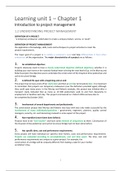Summary
Summary PRM 3701 Study Units 1-14 summaries
- Institution
- University Of South Africa (Unisa)
- Book
- Project Management
Full summary of project management (study guide and textbook) from Study unit 1 - 14. Summaries include diagrams, tables and formulas relevant to the module.
[Show more]




